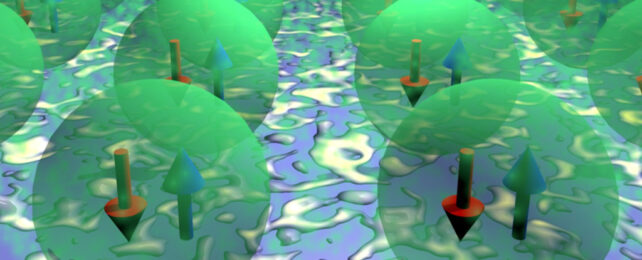Crafting organic molecules into a bizarre kind of magnet, physicists from Aalto University and the University of Jyväskylä in Finland have created the perfect space for observing the elusive activity of an electronic state called a triplon.
Where a garden variety magnet is typically best described as having two poles surrounded by a nest of field lines, the curious construct known as a quantum magnet defies such a simple description.
As is the case any time the word 'quantum' appears, you can imagine a landscape where nothing is certain. Like spinning roulette wheels in a dimly lit casino, all states are a maybe until the croupier says "no more bets".
Weirder still, numbers and colors on one wheel are entangled with those on other wheels in non-intuitive ways, such that a result of black on one might mean landing on red on another.
With north and south reduced to a flux of probabilities, quantum magnets have properties your fridge magnet lacks, making them handy objects for exploring phenomena that aren't easily spotted in most other environments.
One such behavior is a wave of quasiparticles known as triplons.
Reach into an atomic bag and pluck out an electron. There's an equal chance it will have one of two spins, or flavors of angular momentum. Find an electron with the opposite spin and the two will cancel out. Congratulations, you have a singlet state of electrons!
Throw in a third electron and you'll add another tiny amount of twist, creating a doublet.
But what if the two in your initial pairing have the same spin? Instead of canceling, they now build into a triplet state.
Although the two electrons in a triplet are often parked in their own distinct atomic orbits, physicists can conveniently group their characteristics together and treat them as a 'sort-of-particle': a quasiparticle.
In this particular case, the spins of triplet states are treated as single particles called triplons, and come with distinct behaviors all of their own. Entangled together across a material, they can surge and move about in curious ways.
This is all well and good in theory, but catching sight of such wave-like behaviors in the wild isn't always easy to do.
Here, by building quantum magnets from a mix of cobalt atoms and phthalocyanine molecules, the researchers created the right conditions to force electrons to interact as triplon quasiparticles and then propagate their properties through the solid.
"Using very simple molecular building blocks, we are able to engineer and probe this complex quantum magnet in a way that has never been done before, revealing phenomena not found in its independent parts," says the study's first author Robert Drost, an applied physicist from Aalto University.
"While magnetic excitations in isolated atoms have long been observed using scanning tunneling spectroscopy, it has never been accomplished with propagating triplons."
It's not the kind of discovery that will revolutionize the way you stick your kid's treasured drawings to the fridge door, but quantum electronics are proving useful in computing and encryption.
Possessing a few new tools to manipulate quasiparticles in a quantum casino can never go astray.
"This strategy shows that we can rationally design material platforms that open up new possibilities in quantum technologies," says Jose Lado, head of the Correlated Quantum Materials research group at Aalto University.
This research was published in Physical Review Letters.
